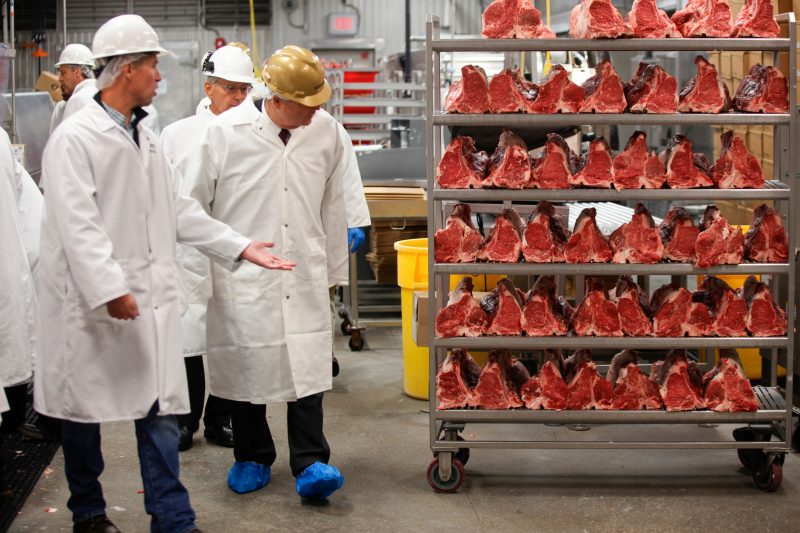Since Congress created the Occupational Safety and Health Administration (OSHA) a half-century ago, it has pursued a mission “to ensure safe and healthful working conditions for workers.”
But a new report from the government’s main watchdog shows that during the coronavirus pandemic, the agency repeatedly was missing in action in a lagging effort to protect poultry and meat processing workers. That problem persists today.
“OSHA is developing an infectious disease standard for healthcare workers, but not for workers in meat and poultry processing,” according to a Government Accountability Office (GAO) study issued last month. “Without assessing the actions needed to better protect meat and poultry workers — such as assessing the need for an industry standard — OSHA may be missing an opportunity to protect workers.”
The danger in that missed opportunity is demonstrated by OSHA’s finding that the 2020 coronavirus risk to workers in a large South Dakota meat plant was 70 times greater than the risk to the state’s population generally.
Protecting the workers would be more efficient if silo vision and bureaucratic tensions didn’t hinder OSHA and a sister agency, the Food Safety and Inspection Service (FSIS), from working together better. Despite cooperation agreements between the two agencies, there is “little field-level collaboration among staff with direct knowledge of plant conditions,” GAO reported. “OSHA and FSIS missed opportunities to collaborate during the pandemic, and did not follow most leading collaboration practices.” OSHA, a Labor Department agency, focuses on worker safety. FSIS, part of the Agriculture Department, focuses on the safety of poultry and meat products.
The missed opportunities, according to GAO, include:
• Not including FSIS officials in all meetings about the pandemic’s effect on the meat and poultry industry in 2020 when covid-19 was spreading rapidly. OSHA and FSIS began meeting weekly in January 2021, then monthly starting that November, but they did not document the sessions and “officials were unable to provide details such as what was discussed and what collaboration activities occurred as a result.”
• “OSHA and FSIS missed opportunities to collaborate on worker safety in these meetings by not including field staff, who had direct knowledge of conditions at meat and poultry plants and who could have provided information about protecting plant workers during the pandemic.”
• From February 2020 through June 2022, OSHA did 162 covid-related inspections of meat and poultry plants, but the inspectors “did not contact FSIS officials who were present in plants for them to identify conditions that may affect workers.”
• OSHA and FSIS have had a memorandum of understanding outlining their areas of cooperation since 1994, but along with other agreements, it was “ineffective for implementing a government-wide approach for large-scale safety and health crises, such as the covid-19 pandemic.”
FSIS and OSHA updated their 1994 memorandum in 2022. The 2022 document says “FSIS will inform OSHA” if FSIS finds information about infectious diseases in a workplace. But the new agreement, GAO said, “did not incorporate most leading collaboration practices.”
Calling FSIS “a captured agency by the meat and poultry industry,” Debbie Berkowitz, who was OSHA’s chief of staff during the Obama administration and previously a United Food and Commercial Workers International Union (UFCW) official, complained that FSIS generally rejected OSHA’s offers for cross-agency training when she was there. “The Trump administration allowed the meat industry to get away with a stunning failure to protect meat and poultry workers during the pandemic,” she said.
GAO’s findings are not news to UFCW President Marc Perrone.
Charging that “the Trump administration bowed to corporate pressure,” Perrone said GAO “confirms what we already know. The previous administration’s carelessness and ineptitude likely cost the lives of meatpackers and needlessly endangered their families during the height of the pandemic.”
Former president Donald Trump’s presidential campaign did not respond to requests for comment.
In a statement emailed to The Washington Post, FSIS said it “took decisive action to implement federal guidance and recommendations to protect the safety and well-being of its employees while continuing to ensure the safety of our nation’s food supply” and “is committed to ongoing collaboration with OSHA to resolve challenges and incorporate leading collaboration practices.” OSHA said it is reviewing the report and “will issue a Statement of Executive Action shortly.”
Tom Super, a spokesman for the National Chicken Council, a trade association, said “the chicken industry showed enormous resiliency and innovative spirit in responding [to the pandemic]. Workplaces were adapted, and then adapted again as we learned more about the virus. The data show these efforts worked.”
Sarah Little, with the North American Meat Institute, said “there was widespread confusion among health authorities about how the disease spread,” early in the pandemic, and many people “called for better operating guidelines” from Washington. As more became known, she added, “meat and poultry companies implemented more than $1.5 billion in comprehensive protections and as a result, covid rates among industry employees dropped and stayed well below infection rates in the nation, even during the Omicron surge.”
The reasons for the lack of interagency cooperation are familiar to bureaucracies, including a narrow, segmented approach to issues. But one reason GAO cites is notable for its obstructive, interagency competitiveness: FSIS “personnel may be reluctant to contact OSHA about plant hazards,” GAO said, “because an inspection could result in an OSHA citation of FSIS.”
It sounds petty, but this means FSIS employees in a food plant might not report a violation of OSHA regulations to OSHA because OSHA employees might retaliate by inspecting an FSIS facility. “OSHA inspectors view FSIS as an employer that OSHA regulates,” GAO wrote, “rather than as a federal partner.”
Despite the seriousness of the pandemic and the overlapping nature of their work, “OSHA and FSIS officials in the field,” GAO reported, “generally were unaware of any collaboration activities during the pandemic.”
































